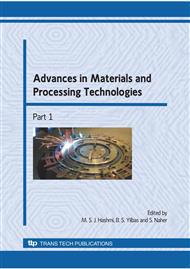p.1197
p.1205
p.1212
p.1220
p.1228
p.1236
p.1243
p.1251
p.1254
Experimental Models for Assessment of Interfacial Heat Transfer in Dip Soldering
Abstract:
The success of a numerical simulation for solder solidification during soldering processes depends on an accurate knowledge of heat transfer phenomenon at the solder/substrate interface. Two experimental setups were designed to study the interfacial heat transfer at solder/substrate interface. In the first method, a cylindrical probe of substrate material was dipped in liquid solder and solder was allowed to solidify around the metal probe. In the second method the test probe was dipped in the bulk solder liquid of sufficiently large quantity and allowed to attain the surrounding solder liquid temperature. Temperature at the center of the probe was measured using thermocouple. Heat flux transients at the surface of the probe were estimated by lumped heat capacitance method. SEM study at the solder/substrate interfacial region for experiments of solidifying solder around the test probe revealed the existence of a clear gap with aluminum substrate. A conforming contact was obtained with copper substrate. The nature of heat flux transients was found to be different in two experiments.
Info:
Periodical:
Pages:
1228-1235
Citation:
Online since:
December 2009
Authors:
Keywords:
Price:
Сopyright:
© 2010 Trans Tech Publications Ltd. All Rights Reserved
Share:
Citation:


